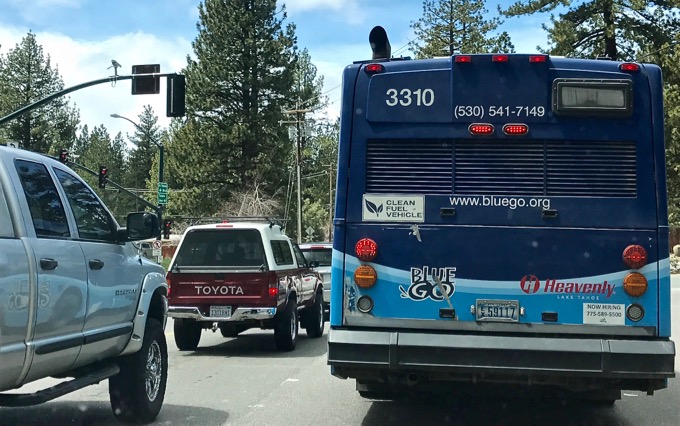TTD develops road map for functional transit

Reliable, coordinated transit is not something the Lake Tahoe Basin is known for. Photo/LTN
By Kathryn Reed
STATELINE – Transit is about getting people where they want to go, providing choices and creating connections.
That is what Tahoe Transportation District is striving for in the basin and beyond.
Carl Hasty, the bi-state agency’s leader, on April 26 talked to the Tahoe Regional Planning Agency’s Governing Board about the Lake Tahoe Basin Transit Master Plan. It is a multi-year plan with short- and long-term goals.
“The vision here really means we are going to see buses everywhere,” Hasty said.
Transit operators know that just putting buses into the mix and having them stopped in traffic is not solving the problem. Removing individual vehicles from the roads will lessen congestion. Those people, though, need to be able to rely on transit. Today, that is not possible.
The ultimate goal is bus service every 15 minutes.
Today 1.4 percent of road trips in the basin are via transit. The most aggressive planning scenario has the percentage growing to 20. That is projected to remove more than 7 million auto trips a year. Benefits would include having fewer vehicles on the road, and less emissions – a boon for air and water quality. The net operating cost to do is estimated to be more than $13.6 million a year.
Before all those new buses are ordered (once the money is in hand to do so) transit officials need to figure out where they will be housed, along with where to set up maintenance and fueling locations. Space is tight for the current operations in the basin.
The board appeared to be in consensus that the tourist should be footing the bulk of the transit bill. How exactly remains to be seen. Toll roads and taxes of some kind are potential outcomes.
Hasty said it’s likely federal transit dollars will be dramatically cut in the Trump administration’s “skinny” budget.
Layers of service are what’s needed to accommodate locals and the influx of tourists. And then it’s adapting to the different tourists – their activities and desired destinations. It also means keeping an eye on points west and east in regards to people coming to the basin in hopes that down the road an even broader public transit system could be coordinated with one that is focused on the Tahoe-Truckee areas.
“It needs to be seamless to the public. They don’t care as long as it gets them to where they want to go and it’s safe,” Hasty said.
Hasty didn’t mince words in stating it’s time to realize parking – the lack of it – is one of Tahoe’s major problems. People park on highways, clog trailheads and creates dangerous situations. Much of the parking in the basin is on private property. Public parking is what’s needed.
Mobility hubs is the newest catch phrase. It’s a place to connect people to transit, as well as bike-foot paths. TTD staff has plotted out where they might be located.


